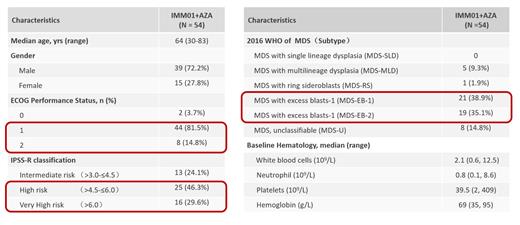Background:
Patients diagnosed with higher-risk myelodysplastic syndrome (MDS) have poor prognosis. IMM01 is a recombinant signal regulatory protein α (SIRPα) IgG1 fusion protein that exerts anti-tumor activities via blocking “Don't eat me” signal and activating the “Eat me” signal to induce strong antibody-dependent cellular phagocytosis (ADCP). Furthermore, IMM01 activated macrophages could process and present tumor antigen to T cells and elicit long-last tumor-specific T cell immune response.
Methods:
This is an open-label, multi-center, phase 2 study (NCT05140811) that evaluated safety and efficacy of IMM01 in combination with AZA as the first-line treatment for patients with untreated higher-risk MDS. Enrolled patients were aged ≥18 years with intermediate to very high risk MDS (IPSS-R >3.5) who were not eligible for stem cell transplant or intensive chemotherapy. Patients with treatment-naive MDS were administered intravenous IMM01 at a dosage of 2.0mg/kg/week and subcutaneous AZA at a dosage of 75 mg/m 2 on D1-7 per 28-day cycle. Adverse events (AEs) were reported according to CTCAE v5.0. Efficacy was assessed by IWG 2006 (MDS) criteria.
Results:
A total of 54 patients were enrolled from June 29, 2022 to June 11, 2023. The median age was 64 (30-83) years, with 39 (72.2%) being male, and 52 (96.3%) having an ECOG of ≥1. Based on risk classification per IPSS-R, 13 patients (24.1%) were intermediate risk (IR), 25 (46.3%) high risk (HR), and 16 (29.6%) very high risk (vHR). At baseline, the median levels of blood counts were 69 (35-95)g/L for hemoglobin, 39.5 (2-409)×10 9/L for platelets and 0.8 (0.1-8.6)×10 9/L for neutrophils. By the data cut of June 11th, 2023, the median duration of follow-up was 5.6 months (95%CI:3.6-7.9). Among the 22 efficacy evaluable patients who received initial treatment of ≥4 months, overall response rate (ORR) was 81.8% (18/22), including 36.4%(8/22) complete response (CR) rate, 22.7%(5/22) marrow CR (mCR) with hematologic improvement (HI), 9.1% (2/22) HI and 13.6% (3/22) mCR alone. Among the 17 efficacy evaluable patients who received initial treatment of ≥6 months, ORR was 88.2%(15/17), including 41.2% (7/17) CR, 29.4% (5/17) mCR with HI, 5.9% (1/17) HI and 11.8% (2/17) mCR alone. The median duration of response (DoR) was not reached. Biomarker data showed mutation burdens of several markers, including TP53, DNMT3A, ASXL1, U2AF1, were dramatically reduced on study treatment. The most frequent treatment related adverse events (TRAEs) (≥20%) were leukopenia (85.2%), thrombocytopenia (72.2%), neutropenia (66.7%), lymphopenia (57.4%), anemia (44.4%), vomiting (44.4%), pyrexia (33.3%), infusion related reaction (33.3%), constipation (29.6%), nausea (25.9%), hypoalbuminemia (22.2%) and infection (20.4%). The most common ≥G3 TRAEs (≥10%) included leukopenia (81.5%), thrombocytopenia (68.5%), neutropenia (66.7%), lymphopenia (57.4%), anemia (44.4%) and infection(16.7%). These AEs were consistent with the AE profile of the AZA monotherapy in treatment-naive MDS as commonly reported in China. Without using of a low priming dose, no Grade ≥3 hemolysis occurred. The study is ongoing.
Conclusions:
Preliminary data from IMM01 (without low-dose priming) combined with AZA were well tolerated and showed exciting efficacy results in patients with treatment-naive higher-risk MDS.
Disclosures
Dong:ImmuneOnco Biopharmaceuticals (Shanghai) Inc.: Current Employment. Yang:ImmuneOnco Biopharmaceuticals(Shanghai) Inc.: Current Employment. Lu:ImmuneOnco Biopharmaceuticals(Shanghai) Inc.: Current Employment. Tian:ImmuneOnco Biopharmaceuticals (Shanghai) Inc: Current Employment, Current equity holder in private company.


This feature is available to Subscribers Only
Sign In or Create an Account Close Modal